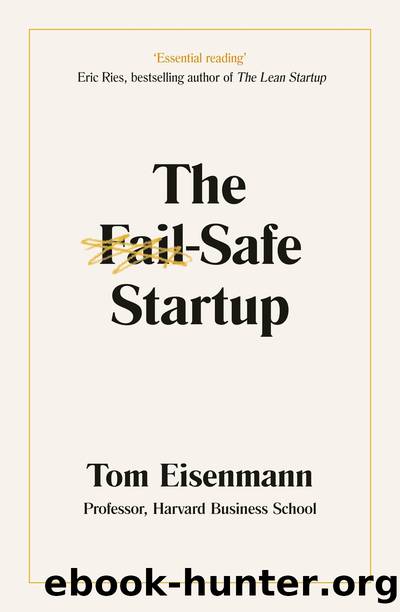The Fail-Safe Startup by Tom Eisenmann

Author:Tom Eisenmann [Eisenmann, Tom]
Language: eng
Format: epub
ISBN: 9780241987780
Published: 2021-11-04T00:00:00+00:00
As Graham notes, many entrepreneurs who lead successful startups have the option to avoid raising more venture capital and could instead fund slower growth through internally generated cash flow. However, passing up more venture capital âon terms theyâd be crazy to refuseâ might forfeit the entrepreneurâs opportunity to become really rich. So, if a startup could scale rapidly but is not impelled to do so by competitors (more on this below), what might hold them back?
First, an entrepreneur faces a radically different risk-reward scenario than a venture capital investor. Assume that scaling rapidlyââswinging for the fencesââhas a 1 in 20 chance of earning a huge payoff. With a few dozen companies in its portfolioâthat is, with dozens of âat batsââa venture capital firm can reasonably expect at least one home run, along with a few singles and doubles. Averaging across all of these outcomes, the VC should earn a good return on its investments, even with plenty of strikeouts. By contrast, entrepreneurs donât deal with averages; they get just one turn at bat, and if swinging for the fences significantly boosts their odds of striking out, too, they might prefer a safer strategy.
As an example, if you, as a founder/CEO had one shot, would you rather have 1) a 10 percent equity stake in a startup that has a 5 percent chance of being worth $1 billion; or 2) a 25 percent equity stake in a startup that raised much less capital, grew more slowly, and has a 10 percent chance of being worth $200 million? In terms of personal wealth creation for the founder, both options have the same expected value: $5 million. But with the hypergrowth option, the founder has half the chance (5 percent vs. 10 percent) to earn twice as much ($100 million vs. $50 million).
Second, scaling at high speed puts tremendous personal pressure on a CEO. The hours can be brutal and filled with a constant stream of calamities. Everything happens faster: hiring mistakes, firings, service problems, customer defections. Of course, if things are going well, achievements come faster, too. Some leaders thrive under such pressure and derive great satisfaction from taming the chaos. Others, after skipping yet another childâs recital or one more friendâs wedding, may ask, âIs this really worth it?â
Finally, if a founder still holds the CEO role and chooses to scale her venture at a faster rate, she must accept the higher odds that sheâll be replaced. Faster growth means raising more rounds of venture capital, and each round typically adds a new investor to the board of directors. Investors will eventually control a majority of board votes and can dismiss the CEO if sheâs struggling. A founder who relishes the power that comes with the CEO role, or whoâd be distraught at being separated from a venture to which sheâs passionately attached, should weigh this risk.
This final concern points to an underlying issue with being Willing to scale. âFast or slowâ isnât solely up to the founderâitâs a board-level decision.
Download
This site does not store any files on its server. We only index and link to content provided by other sites. Please contact the content providers to delete copyright contents if any and email us, we'll remove relevant links or contents immediately.
Time Management Made Easy: How to Cultivate New Habits, Improve Productivity and Get Things Done by Joshua Strachan(2371)
The 7 Habits of Highly Effective People by Stephen R. Covey & Sean Covey(2164)
The Concise Laws of Human Nature by Robert Greene(1737)
Doesn't Hurt to Ask by Trey Gowdy(1566)
Primal Leadership by Daniel Goleman(1155)
Hook Point: How to Stand Out in a 3-Second World by Brendan Kane(1100)
HBR's 10 Must Reads 2021 by unknow(1051)
Don't Sweat the Small Stuff...and It's All Small Stuff by Richard Carlson(1027)
Amazon Unbound by Brad Stone(988)
100 Things Successful People Do by Nigel Cumberland(971)
HBR's 10 Must Reads 2021 by Harvard Business Review(963)
The Job Closer by Steve Dalton(945)
Master of One by Jordan Raynor(940)
Lives of the Stoics by Ryan Holiday & Stephen Hanselman(905)
Declutter Your Mind: A step by step guide to learn to control your thoughts, stop worrying, relieve anxiety and eliminate panic attacks and negative thinking by Mia Chandler(888)
The Power of 100! by Shaun King(877)
Conflicted by Ian Leslie(807)
Coders at Work: Reflections on the craft of programming by Peter Seibel(794)
The Book of Hope by Jane Goodall(757)
